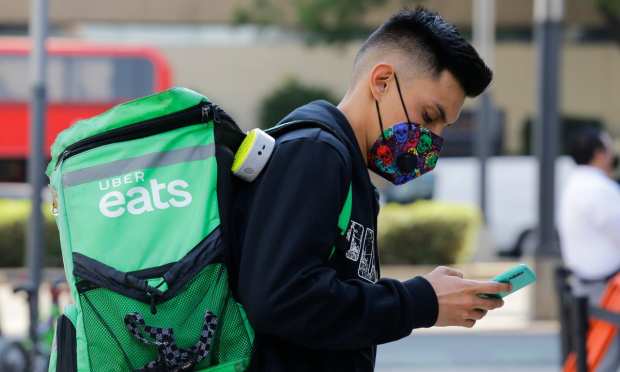Uber Earnings: Delivering Food Runs Miles Ahead Of Delivering People

Uber delivers people. Uber delivers food. One of these businesses was uniquely suited to the digital-first economy. That became clear on the company’s earnings call on Wednesday as its fourth-quarter and full-year results took the measure of Uber’s business model and the potential impact of recent acquisitions.
A quick look at the numbers shows the dichotomy between Uber and Uber Eats and places it in the context of the company’s future, which will include recent acquisitions Drizly and Postmates. Overall, Uber reported a net loss of $6.76 billion for 2020, compared with an $8.5 billion loss in 2019. Revenue for the year declined 14 percent to $11.13 billion. Perhaps the best way to look at the company’s numbers is through the lens of gross bookings: Delivery Gross Bookings grew 128 percent over 2019, and Mobility Gross Bookings declined 47 percent as the digital shift kept people away from traveling and away from groceries and restaurants. In December, according to CEO Dara Khosrowshahi, the annual delivery bookings hit an annualized rate of $44 billion.
“While the external environment remains uncertain, I am more optimistic than ever about Uber’s future,” Khosrowshahi told the firm’s earnings call. “We’ve established the world’s largest mobility platform with a leading position in every major region that we operate in. In five years, we built the world’s largest food delivery platform outside of China, which is growing substantially faster than the category, and which we’re using to demand to expand into high potential adjacencies. These two platforms are synergistic and they are powered by many common components.”
The company is betting that the digital-shift’s common components and the expected pandemic recovery will converge to bring the mobility business back to 2019 levels and will continue to drive the “bring it to me” economy. On the mobility side, some of the new features and services added during 2020 started to show some traction. Uber Reserve, its premium reservations service, is now in 20 U.S. cities. Uber Transit, which service enables riders to plan and travel trips across transit platforms, was launched in Q3 in Sydney and Chicago. Uber for Business bookings grew 45 percent in Q4 over Q3. Total platform customers across all mobile and delivery grew to 93 million in Q4. On average, the monthly active consumer spent over $60 across more than 5 transactions on Uber’s platform.
But the excitement on the call and for the company was reserved for Uber Eats. Restaurants now on the platform topped 600k, with 100k coming from the Postmates acquisition, which closed on Dec. 1. Grocery and non-food deliveries grew to a $1.5 billion rate for the year. Gross Bookings and Revenue grew triple digits year-over-year, with EMEA up 144 percent and the U.S. and Canada up 142 percent.
Khosrowshahi said he welcomed the intense competition in the delivery space.
“Listen, the only environment we’ve known in delivery is competitive,” he said in response to an analyst question. “We were relatively late to the game, there were a bunch of players who had already been, in some cases incumbent. And I think based on the results that you’re seeing, we are able to grow the business faster than the category and improve margins. And I think that speaks to the power of the platform and it speaks to the fact that we have access to many common components as they relate to our technology. So I wouldn’t characterize the competitive environment as getting any better or worse, I would characterize it as continuing to be intense.”
Khosrowshahi also addressed the Drizly acquisition, noting that regulatory environment for the company is different from state to state. “We saw that the Drizly team built fast and built profitably,” he said. “So I think putting together like a product that has a first-class merchant base that is highly penetrated and introducing them to the giant audience that we have is a pretty powerful combination.”
